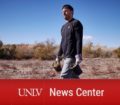 MAYA ZAWLODZKI
MAYA ZAWLODZKI
Nevada State College
Mentor: Bryan Sigel
Molecular Ecology of Canis Latrans in the Las Vegas Valley
Several recent media reports suggest an increasing number of coyote (Canis latrans) sightings and incidents around the Las Vegas Valley. The goal of this study is to determine whether there is a resident population of coyotes within the urban community of the valley or whether coyotes penetrate the city from surrounding desert habitat. This is done by tracking movement patterns of individual coyotes through the collection and genetic analysis of scat samples. Coyote scat is gathered at several urban and edge sites throughout the valley that have high numbers of coyote sightings. DNA is extracted from the scat samples and polymerase chain reaction (PCR) and gel electrophoresis are used to determine whether the DNA is adequate for further analysis. Restriction enzyme analysis is used on an mtDNA sequence unique to coyotes to verify that the scat sample is of coyote origin. Six microsatellite markers on genomic DNA are used to identify individual coyotes. Samples are mapped using GIS to determine home range size, habitat preference and movement patterns of individual coyotes. Approximately 60 samples have been gathered from three sites: Sunset Park, Wetlands Park, and Anthem. Of these samples, 58 have been processed for DNA extraction so far. Some challenges faced by the study include difficulties extracting quality DNA from samples exposed to the extreme temperatures and low humidity of the desert climate of southern Nevada.




